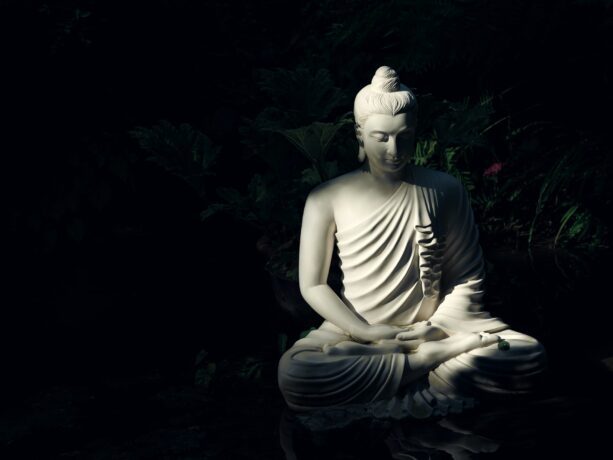Our mind defines our life; we are what we think. Suffering follows evil thoughts as the wheels of a cart follow the oxen pulling it.
Our mind defines our life; we are what we think. Joy follows pure thoughts like shadows that never leave.
Dhammapada 1.1,2
Buddha means the Awakened One. Siddhartha Gautama, a minor prince borne in what is today’s Nepal, renounced all the pleasures his life generously afforded him at 29, leaving behind his parents, wife and child, seeking a solution to the miseries of ill health, old age and death that he witnessed around him. Six years later, after intense meditation followed by severe austerities, and then by a more moderate middle path, he awoke into a state of consciousness he termed nibbana in his native Pali, nirvana in Sanskrit, meaning ‘extinguishing. This state ended suffering by extinguishing desires.
Buddha died at 80 of old age and ill health, yet in complete acceptance. By then, he had created a community of men and later women, as his Sangha, the Community of monks, to follow his Dhamma, the righteous pathway to nibbana. Buddham saranam gacchami, Dhammam saranam gacchami, Sangham saranam gacchami, chant the monks and believers every day as the Three Jewels prayer, ‘I take refuge in the Awakened One, I take refuge in his noble teachings of the righteous path, I take refuge in his community.’
Parables of Buddha abound. Gautami came to him to seek the resurrection of her dead child. Buddha asked her to bring a spoonful of mustard from any house that has not witnessed death to allow him to revive the child. By sunset, realizing the inevitability of death and its acceptance, Gautami returned to seek his refuge. His own wife Yashodhara sent her seven-year-old son Rahula, when Buddha visited his home in Kapilavatsu that he had renounced, to seek his inheritance from his father. Buddha changed the little boy’s fineries to the saffron robes, taking him as his only child disciple. At Bimbisara, while kings and nobles waited in line with lit metal lamps that were snuffed out by a gust of wind, he went to a lonely poor old woman clutching a broken earthen lamp with a few drops of oil, which was miraculously burning. He taught Sona, a disciple, the Middle Path, as Sona helped him string the Veena neither tight nor loose. Buddha’s truths were expressed through his parables.
In Buddha’s days, the Vedic religion was practiced at two levels. At one level of the understanding of the Upanishad and the essential spirit of the scriptures, spiritual seekers looked for the larger truth, and these were few in number. The large majority of the society was influenced and controlled by the priests and brahmins, and it depended on their interpretation of the Veda through its ritualistic interventions, enhancing the latter’s power and wealth. Buddha rebelled against this, as did another prophet 500 years later against the pharisees and priests in Jerusalem. This period of 500 BC seemed to have generated multiple such rebels, Socrates in Greece, followed by Aristotle and Plato, questioning traditions; Lao Tzu and Confucius in China who rewrote traditional beliefs;Mahavira Jina in another part of India, whose followers are the Jains.

- In his first teaching to the small group of disciples who had followed him, he taught the 4 Noble Truths and the 8-fold path of righteousness. These were:
- Life is impermanent; it’s suffering
- Selfish desire causes suffering; desire is never ending.
- Extinguishing desires, nibbana, ceases suffering.
- Nibbana can be reached through the 8-fold path of
Right, Understanding, which is to stand firm midst change looking inwards, and Right Purpose, which is to follow this Understanding in thoughts and action, followed by Right Speech, Right Conduct, and Right Livelihood, which act upon Right Purpose by treating others as you treat yourself in kindness, love and compassion. These can be compared with the concepts of Yama and Niyama in Yoga.
Right Effort to train the mind and body diligently to ensure Right attention and Right Meditation to focus the mind and finally detach oneself from it. Right Effort can be compared with the practices of Asana and Pranayama, while Right Attention and Right Meditation can be compared with the last 4 internal Yoga principles of Pratyahara, Dharana, Dhyana and Samadhi.
Right Attention is often confused with Mindfulness these days. The word Mindfulness is the incorrect translation of the Pali word sati, meaning memory. Right attention of Buddha is about disengaging from sensory inputs, perceptions, memories and thoughts leading to action, moving away from the neurobiological sequence following external data inputs. Mindfulness is practiced as sensory focus and attention going deeper into these useless data, and is hardly Right Attention.
The purpose of Right Attention together with Right Meditation is to lead to sunya, nothingness, the extinguished state of nibbana and no mind. This state is not of ‘no thoughts’, since as long as one is in mind and body matter, thoughts will arise, but of a disengaged and detached witnessing state when the individual is no longer an actor, merely a disinterested observer. At this no mind state of mindlessness, our energy space is infinite.
We are no longer particles rooted in sorrow, but waves dancing in joy.

These 4 Noble Truths and 8-fold path to what Buddha taught his disciples as the 4 stages of meditative awareness to nibbana, before he transited.
- Silencing the mind, controlling the senses, as in pratyahara in Yoga
- Delving deep into sensations and feelings, reliving them as while watching a movie, experiencing pain and pleasures without being involved, as in dharana in Yoga
- Meditating on the space between thoughts, seeking the silence, finding the seeds of thoughts in the deep unconscious, moving from waves to stillness, as in dhyana in Yoga, and finally
- Detaching from thoughts, extinguishing the seeds of one’s ego and personality, observing and not participating, as in the samadhi state in Yoga.
Buddha had high expectations and standards for his Sangha of monks. In the last 2 chapters of Dhammapada, Buddha compares Monks with Brahmins.
‘Monk, empty your boat for it to go faster. Get rid of greed, hatred and selfish attachments to cross the river of samsara to reach nirvana.’
‘A Brahmin is one whose wants are minimal, who is detached from homemakers and the homeless alike, rising above duality free of sorrow.’
In Buddha’s mind, a ‘true’ Brahmin could be a monk.
Much as many may like to separate Buddhism from the Vedic religion, they have to admit that it’s an evolution of the spirituality of the Vedic religion to a far higher plane, while dropping its ritualistic aspects. Unfortunately, over the years Buddhism have also evolved into a ritualistic religion, with the monks taking the role of ‘untrue’ Brahmins, who Buddha derided for the right reasons. Buddha never wanted be God and be worshipped. He left the Bodhi tree as his legacy and symbol. Whenever I enter a Buddhist temple today with its massive idols, some of gold, I can visualize Buddha turning cartwheels in his place of nibbana, in deep discomfort. I shudder in empathy with that noble soul, who many in the Hindu religion, consider an incarnation of Vishnu.
Buddha Jayanti is considered a day thrice blessed, by Buddha’s birth, his enlightenment and his departure. Let’s remember this person who was truly awake on his Jayanti on 16 May this year in my calendar.



